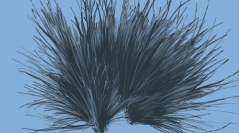

 Cryptogamie, Algologie
42 (2) - Pages 21-37
Cryptogamie, Algologie
42 (2) - Pages 21-37Low levels of diversity and endemism, when compared to red or brown algae, have been reported for Antarctic green marine macroalgae (Chlorophyta). However, recent studies including the use of molecular markers have allowed us to revisit the taxonomical status of species thought to be well known, underlying the existence of unexpected Antarctic flora diversity at local and regional scale. In the present study, samples of green macroalgae along the Western Antarctic Peninsula (from the 62°S down to the 66°S) were sequenced for two genetic markers regularly used for species determination and barcoding in Chlorophyta (i.e., the plastid genes tufA and rbcL). From the 122 specimens of Chlorophyta sampled, 85 were sequenced for the gene tufA and 16 for the gene rbcL. Using the NCBI Nucleotide Blast Tool to compare our sequences to the ones available in public data depositories allowed the identification of 11 species. Three new species were reported for the area: Rosenvingiella radicans (Kütz.) Rindi, L.McIvor & Guiry, Urospora wormskioldii (Mertens) Rosenvinge and Ulvella islandica R.Nielsen & K.Gunnarsson. Furthermore, molecular identification revealed strong match (> 95%) between our Antarctic sequences and the ones obtained for samples from the northern hemisphere for Acrosiphonia arcta (Dillwyn) Gain, Prasiola crispa (Lightfoot) Kützing, Prasiola antarctica Kützing 1849, R. radicans, Ulva sp. A-GW, U. islandica, Urospora penicilliformis (Roth) Areschoug and U. wormskioldii confirming the amphipolar distribution of various taxa of Antarctic Trebouxiophyceae and Ulvophyceae. Amphipolar distribution seems more common in green than red or brown Antarctic seaweeds, so here we hypothesize that recurrent occurrence of long dispersal events could explain the low level of endemism observed for this phylum along the Antarctic coasts.
Antarctic, Chlorophyta, barcoding, tufA and rbcL, amphipolar distribution, endemism